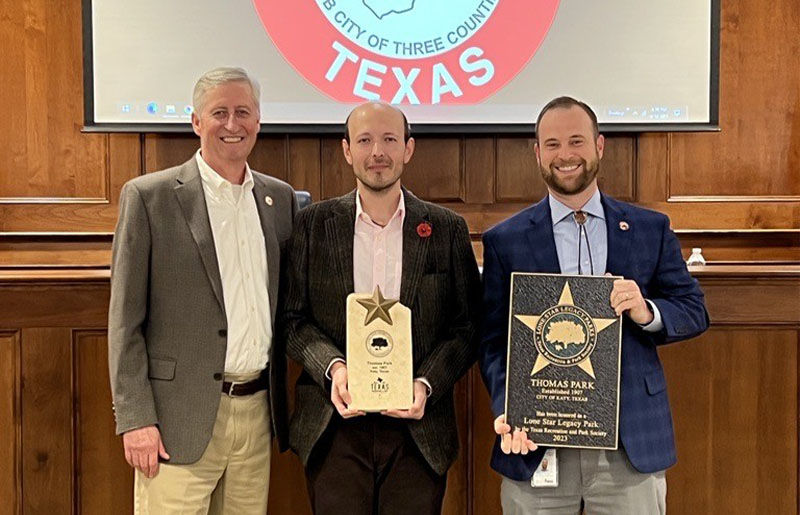
Thomas Park Receives Lone Star Legacy Designation
Six Texas parks were honored with designation as a Lone Star Legacy Park by the Texas Recreation and Parks Society (TRAPS) in a ceremony at the association's annual institute in Frisco on March 1, 2023., including Thomas Park in Katy.
A Lone Star Legacy Park is classified as a park that holds special prominence in the local community and the state of Texas. To qualify for consideration, the park must have endured the test of time and become iconic to those who have visited, played and rested on its grounds. Nominated parks must be a minimum of 50 years old and had to meet at least one of the following criteria:
-
The property represents distinctive design and/ or construction.
-
The park is associated with historic events or sites.
-
The park is associated with events specific to the local community/ state.
-
The park is home to unique natural features.
The City of Katy traces its roots to 1839, when James Crawford, a veteran of the Texas Revolution, hired a surveyor from Harris County to fix the boundaries of a land grant near Cane Island Creek, a small branch of Buffalo Bayou on the northwestern edge of the modern city. The land grant was approved in 1845, and for the next fifty years the area remained sparsely populated.
As the tum of the century drew near, development in the Cane Island area increased. In 1890, a surveying team lead by Milton August Beckendorff established the intersection of Harris, Fort Bend, and Waller counties, on the bank of Cane Island Creek. They erected a stone marker at the spot, which still stands today. Also drawing near was the railroad. In 1894, the Missouri-Kansas-Texas Railroad reached Cane Island on its way to Houston and Galveston.
In December 1895, James Oliver Thomas, a settler from Missouri, purchased 46 acres of land from the James Crawford survey, and hired L. C. Luckel and P.M Cash to plat a townsite along the tracks of the MK.T Railroad. Thomas applied for a post office, and on the application, listed the name of the new townsite as Katy, after the MKT Railroad. Thomas was appointed as postmaster and owned and operated a general store: a lucrative business in a developing frontier.
Thomas, Luckel, and Cash purchased much of the land they surveyed, selling parcels to would-be settlers. However, they set aside land for a town square, a church, a school, and a park. On December 23, 1907, the trio donated the park land to the town. This small piece of land on the banks of Cane Island Creek was named Thomas Park, and for much of the next seven decades would remain as an undeveloped reminder of the Katy Prairie's natural appearance as the town-and after 1945, the city of Katy grew around it, even as Buffalo Bayou itself was rerouted from the east to the west of the park.
In April of 1975, the Horizons Committee of the Tri-County American Revolution Bicentennial Commision set its sights on Thomas Park for redevelopment as a Bicentennial Park, in honor of the nation's 200th birthday. The wild grasses were landscaped, and a playground installed, with a walking path and memorial gazebo added to transform Thomas Park into a true multi-use space for all ages. It was formally rededicated on July 4, 1976.
Parks have played an important role in the development of our communities throughout history. Local parks help promote community, natural respite and social interaction as communities were founded, developed and prospered and all parks so designated will be included in a state-wide initiative promoting Heritage Tourism.
Six parks received the honor in the eleventh year of the statewide program. Parks recognized include Pan American Neighborhood Park, Austin; Veterans Park, Boerne; Bunche Park, Fort Worth; Thomas Park, Katy; Brackenridge Park, San Antonio; and Mother Neff State Park, Texas Parks and Wildlife Department. TRAPS is a non-profit 501(c)3 professional and educational organization founded 75 years ago with a membership of over 2,000 professionals. TRAPS is committed to advancing the field of parks, recreation and leisure services in Texas, while advocating for enhanced recreation opportunities and the increase of public green space for Texans. For more information about Texas Recreation and Parks Society, please visit traps.org.







